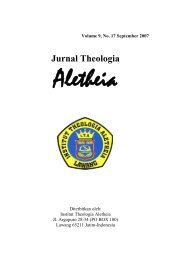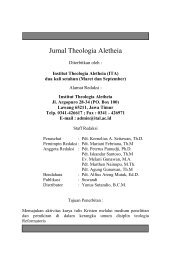download - Sekolah Tinggi Theologia Aletheia Lawang
download - Sekolah Tinggi Theologia Aletheia Lawang
download - Sekolah Tinggi Theologia Aletheia Lawang
You also want an ePaper? Increase the reach of your titles
YUMPU automatically turns print PDFs into web optimized ePapers that Google loves.
89<br />
T<br />
The Shema‘ And The Parable<br />
of The Good Samaritan<br />
Tan Kim Huat<br />
here is a charitable organisation in Singapore which calls itself<br />
the Samaritans of Singapore (SOS). This is set up to help<br />
people facing crises in life, especially those who are contemplating<br />
suicide. From the ethnic point of view, the name is quite a<br />
misnomer as it is almost certain there are no Samaritans in that<br />
organisation or in Singapore, for that matter. Such a name could be<br />
chosen only because of the parable Jesus told. The central character<br />
of the parable inspired the name.<br />
This parable is also the subject of much study and speculation<br />
by the Christian church. Throughout the long years of church<br />
history, the parable has been understood either in an allegorical or<br />
moral way. The parable was understood in the first few centuries<br />
after the demise of the apostles as telling the story of the fall of<br />
Adam or mankind and their redemption through Christ, who is<br />
represented by the figure of the Samaritan. The details may differ<br />
but the tenor remains the same. 107 Such a line of interpretation<br />
continued even to the 19 th century with no less than a figure as R.C.<br />
Trench 108 advocating it. Since the publication of the work of Adolf<br />
Jülicher, 109 such interpretations have now been largely abandoned<br />
and most scholars working on this parable regard it as an example<br />
107<br />
Famous scholars adopting this approach included Clement, Origen,<br />
Augustine, and Luther.<br />
108<br />
R.C. Trench, Notes on the Parables of our Lord, London: Macmillan, 1870,<br />
p. 37.<br />
109 2<br />
J. Jülicher, Die Gleichnisreden Jesu, Vol. 1, Tübingen, Mohr, 1899. This<br />
was further developed in the classic by J. Jeremias, The Parables of Jesus,<br />
London: SCM, 2 1963.




